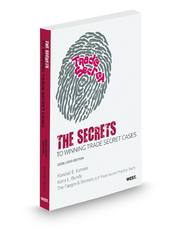Trade secrets often represent the most valuable assets of certain companies. The value of trade secrets continues to grow in our information-age economy as does the mobility of the work force. Both forces are increasing pressure on trade secrets.
The Uniform Trade Secrets Act (UTSA), defines trade secret to mean information, including a formula, pattern, compilation, program, device, method, technique, or process, that: (1) Derives independent economic value, actual or potential, from not being generally known to the public or to other persons who can obtain economic value from its disclosure or use; and (2) Is the subject of efforts that are reasonable under the circumstances to maintain its secrecy.
Trade secrets are easily stolen (or misappropriated) because they represent nothing more than information, which can be easily written down, e-mailed or copied onto some tangible medium and then quietly removed from company premises.
Courts considering cases involving trade secrets must deal with the inevitable competing interests. That is, the rights of individuals to start competing businesses or to continue to work in their chosen occupations — even when this includes leaving an employer to accept a position with a competitor and the rights of the existing business to protect the confidential and proprietary information in which it has invested significant resources.
The accommodation of these often conflicting interests is involved in the resolution of disputes over trade secrets. Two of the primary policy concerns of trade secret law are (1) encouragement of invention, and (2) enforcing ethics in business. Issues that often arise in this area of law that require careful analysis include, (a) what is the actual trade secret, (b) who owns the trade secret, (c) what are the remedies for misappropriation, (d) what efforts must be made to maintain secrecy, and (e) how does trade secret law interface with other laws, including patent, copyright, antitrust, fraud, civil theft, restraints on employment, including non-disclosure agreements, non-solicitation agreements, and non-compete agreements.
Therefore, it is critical to know how to protect trade secrets and how to recover damages if trade secrets are misappropriated by former employees or other individuals.

This book focuses on all the nuts and bolts necessary in trade secret litigation. This is not a treatise that focus on the theory of the law and it is not a practice guide that focuses on protecting trade secrets. This book focuses on strategies to win current cases in litigation and to avoid future litigation and disputes.
Three components help to make the content easily accessible:
- Cases in Point summarizes facts and legal analysis from select cases;
- Secrets of the Trade sheds light on some of the decisions that rarely make their way into reported decisions; and
- Killer Crosses gives examples of short cross-examinations.
Killer Cross Example:
Question [by plaintiff’s attorney]: You were the project leader for this project, correct?
A: Yes, I was the project leader.
Q: You did not follow a clean room process for this project, right? A: What’s a “clean room process?”
Q: The plaintiff provided you a sample of its secret product on the condition that you mention it in confidence, right?
A: That’s right.
Q: And your team that developed your product had access to the plaintiff’s secret product, right?
A: Well, only a couple of them did.
Q: And your product works exactly like the plaintiff’s secret product? A: They seem to be substantially similar, yes.
Q: And none of your competitors have products that work like the plaintiff’s, right?
A: No, but I’m sure they’ve tried.
Q: No further questions.
Case Takeaway:
Clean rooms and the processes they involve may—and often will—be carefully examined by a judge or jury, especially in cases in which clean rooms play a key role. Make sure that your clean room is formed and operated in a manner that will withstand such scrutiny.
This hefty tome provides detailed analysis of every type of trade secret case and how to handle the specifics of each type. The nice aspect of this guide is that it walks you through the process step-by-step from how to identify the issues, to how to begin the case to gaining competitive intelligence. We highly recommend this excellent guide.
“The Secrets to Winning Trade Secret Cases” (West Legalworks; 476 pp., 2009) is available at Amazon.

[…] This post was mentioned on Twitter by Book New Release, PriorSmart. PriorSmart said: Book Review Monday: The Secrets to Winning Trade Secret Cases; http://bit.ly/bo58q0 (at patentbaristas.com) #patent […]
Pretty good post. I just stumbled upon your blog and wanted to say that I have really enjoyed reading your blog posts.Any way Ill be subscribing to your feed and I hope you post again soon
bba india